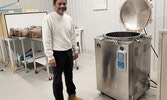Farms to Tables 2025: Sunshine Farms does mushrooms differently near Brussels
BY DEB SHOLDICE
When Amber Sinha and his family purchased a small hobby farm just outside of Brussels, farming wasn’t in their plans. They were just looking for a retreat from their busy lives in Mississauga, and the property seemed to be idyllic and an easy commute.
As they grew to love rural life, Sinha began researching ways that they might utilize the small holding which would allow him to spend more time in the country. Despite being raised in a busy city in India and immigrating to the urban Greater Toronto area, Sinha is discovering the pleasures of country life, although he was surprised by last winter’s relentless snow. Luckily for him, he has a generous dairy farmer with a snow blower as a neighbour who helped him keep the lane open for his staff to get in!
He landed on the idea of specialty mushrooms, despite the fact they weren’t a staple in India where he grew up, and Sunshine Farms was launched. The small footprint required was exactly what he was looking for, since the commodity is high value for a smaller volume of produce.
Last spring, he began construction on a new facility that was exactly what he needed to grow mushrooms. He has now been up and running since July of 2024. By October, the farm was busy and he hired two staff to help him grow the three varieties of mushrooms that they currently produce: oyster (the main crop), lion’s mane and chestnut.
Entering the tidy building, there is a central hallway with several rooms off of it. Each room has a purpose, and the first room is where the substrate bags are filled.
Sinha’s substrate consists of hardwood pellets and soybean hulls, which mimics the dead wood that the mushrooms would naturally grow in. The pellets and hulls are mixed in bags to create a substrate and placed in the autoclave overnight to sterilize, to eliminate any bacteria or contaminants that might compete with the mushroom spores. Millet is added to create a nutritious substrate for the mycelium to grow on, and then only air and water are needed to grow the mushrooms.
Mushroom spores convert to a liquid culture to create “spawn”. Spawn is the mycelium (the vegetative part of a fungus) of oyster mushrooms, that is used to introduce the fungus to a larger growing medium. It serves as the “seed” for growing oyster mushrooms, allowing for the inoculation and subsequent colonization of the substrate. Sinha currently uses a commercially-prepared spawn.
The bags are inoculated with the spawn and then moved to a dark room where they start to colonize. After two to three weeks, the mushrooms begin forming and the bags are cut open to encourage growth. Once the bags are full with mushrooms, the bags are moved to a high-humidity room so the mushrooms will fully fruit. The room is kept at a steady temperature, and the lighting is set to a day/night schedule to mimic the ideal conditions for the mushrooms to mature, usually within two weeks. Oyster mushrooms release carbon dioxide (CO2) as a byproduct of their respiration and decomposition processes, especially during the fruiting stage. This CO2 release is a natural part of their life cycle and Sinha manages this with ultrasonic fans in the growing rooms.
Each bag produces a pound of mushrooms per harvest and is harvested twice. He’s currently harvesting 200 bags per week. Once the bags have produced two harvests, they are no longer viable, but they make great garden compost and are free to anyone who would like to pick them up when available. Because mushrooms attract no pests, the compost is completely pesticide- and fertilizer-free!
Specialty mushrooms have a shorter shelf life than white button mushrooms, so it is crucial to get them to market as quickly as possible. Sinha has a growing network of restaurants, distributors, independent grocers and markets and customers who pick up at the farm.
He is finding the life of a mushroom farmer a complete change of pace from his former career as an investment banker, but is enjoying the challenge of not only growing mushrooms, but also developing the markets. Oyster mushrooms are extremely popular in vegan cuisine, which is a growing market. Sinha has found that Italian restaurants are also an excellent venue for his mushrooms. Lion’s mane mushrooms are used both culinarily and medicinally, particularly in East Asian cultures. In traditional medicine, they are known for promoting longevity, enhancing brain function, and boosting the immune system. They are also used as a food source, with a seafood-like flavor, and are consumed in various forms like raw, dried or cooked. Lion’s mane are also used as a meat substitute, making it popular with his vegan restaurant clientele as well.
Chestnut mushrooms are unique for their rich, nutty flavor, firm texture, and the fact that both their caps and stems are edible and hold up well during cooking. They are also known for their potential health benefits, including immune-boosting and antibacterial properties. They are very versatile and have a firm texture that holds up well during cooking, making them suitable for various dishes like soups, stews and stir-fry recipes.
As Sinha works to develop his direct sales network, wholesaling the mushrooms through the Ontario Food Terminal is the reliable way of making sure the mushrooms get to market while they’re fresh.
Ideally, direct-to-consumer sales at the farm ensures the freshest mushrooms. Mushrooms are available in two-pound cases, by appointment, and tours are available. The farm is located at 43067 St. Michael’s Road, and is open Monday to Friday from 10 a.m. to 6 p.m. Reach out on Facebook or call 416-844-3959 to learn more.


